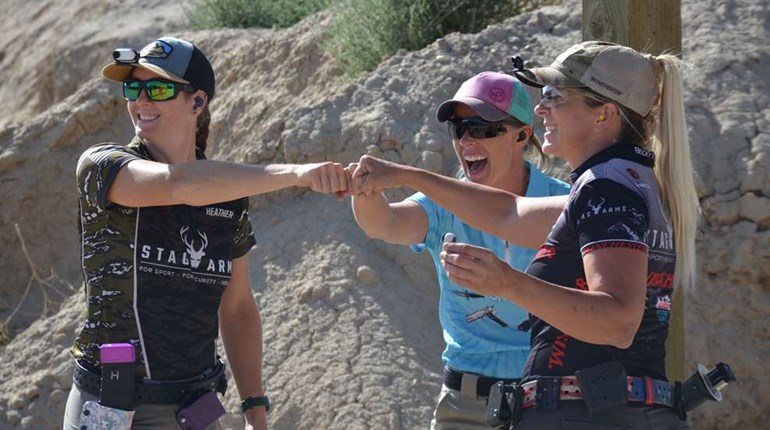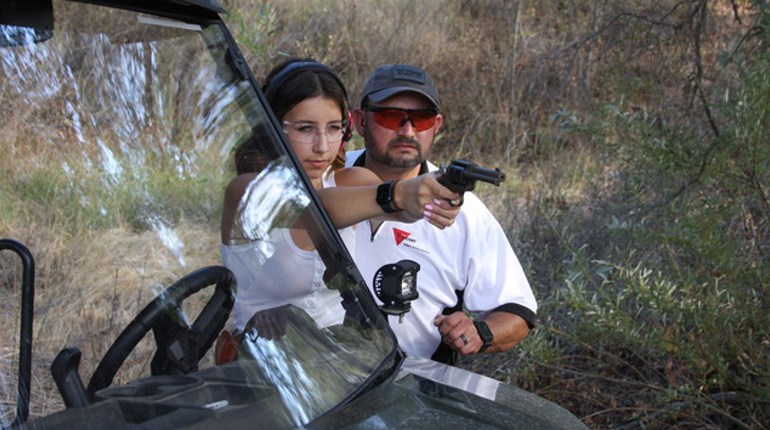
Sometimes coming up with an organized overall approach to something (like defensive training) means breaking down parts of your life and analyzing the pattern. A typical day in the life of an average American has us spending more than a third of our time at home (including eating and sleeping) and more than another third at work. Add a few hours for commuting time, running errands, chauffeuring kids, shopping, etc., and you see a pattern emerging. Number-one and two activities involve home and work, while many others involve time spent in and around our vehicle. If you think your basic defensive-pistol classes prepared you for all these potential vehicle scenarios, you’re in for a shock.
Schools I’ve attended have their training programs pretty well defined and properly focused on what the students are most likely to encounter once class is dismissed. Step 1, teach them safe gun handling so students don’t become a major threat to themselves and those they seek to protect. Step 2, teach them the shooting skills and mindset so they can deal with life-threatening situations and hopefully see those situations developing before being overwhelmed.
But other than recognizing the difference between cover and concealment and learning how to move a couple steps right or left as you shoot, five days of trigger time on a square range and an hour or so of clearing a shoot house will not have you ready for a starring role in the next release of “The Road Warrior.”
Without strapping on your self-defense pistol, take a seat behind the wheel of your car and buckle up. Try to look around you and you’ll notice some serious restrictions to movement and visibility compared to standing in a solid fighting posture on the training range. When you’re in the car, your upper torso is visible from any position in a 360-degree circle around the outside of the car, which means you have neither cover nor concealment for the most vulnerable parts of your anatomy. If you’re right-handed and wear a hip holster like most of us do, you’ll notice all the seat belt hardware converges on and blocks access to your holstered pistol, or would if you were wearing it. Should you be faced with a life-threatening situation while seated, that threat would most likely be approaching you from the driver’s side of the car, which means you’d not only be fumbling for a relatively inaccessible weapon, you’d be bringing the muzzle of the pistol across major portions of your body to deal with the threat. Without any advanced planning or training, a basic reaction to this situation may be to feel trapped and helpless.
The technique for handling this scenario is fairly simple, if you’ve thought about it in advance. If you can drive away, do so. If you can’t, secure the vehicle.” Then grasp the seat belt with your left hand near your left shoulder and slide the hand the length of the belt down to the latch at your right hip. With your right hand, unlatch the belt. Holding the seat belt tab in your left hand, lift it clear of the latch and guide it around the top and outside of the steering wheel up to the connection point by your left shoulder. As the belt retreats toward the anchor point, your right hand draws the pistol and follows the path of your left hand around the top and outside of the steering wheel. As the gun clears the top of the wheel and comes to bear on the driver’s window, your left hand joins the right hand in a solid, two-hand firing grip. At no time during this sweeping draw stroke from your right hip to left-side chest does the pistol’s muzzle cross any part of your body, nor is the seat belt allowed to get tangled on any part of the car. If the threat hasn’t retreated, you deal with it and move on, because the fight isn’t over.
There are a couple other techniques that can be used to initiate the festivities and get you clear of your vehicle. A backup gun, particularly one in an ankle holster, can usually be accessed without releasing the seat belt, which means you can get it into action more quickly. But keep in mind this means you will still have to deal with the seat-belt-release system before leaving the car, and now one of your two hands is holding a pistol or revolver while trying to free you from the seat. In the excitement of a life-threatening moment, particularly since you’ve probably never practiced this move, the gun muzzle will likely be covering lots of anatomical parts you value highly. It’s also possible you could transfer your backup gun (or primary weapon, if it’s small enough) to a chest shirt pocket after entering the car but before driving off. Still, you must ultimately deal with releasing the seat belt if you will be departing the vehicle, perform the same drill if you have removed your pistol from the hip holster to an easily accessible console in your vehicle. I don’t have an answer for you, but it’s something you need to think about before trouble strikes.

We mentioned the lack of concealment or cover while seated in your car, which is a clue you need to be moving. With your gun pointed at the threat, or where the threat was, exit the driver’s-side door and work your way behind your vehicle. If you didn’t eliminate the original threat or if another appears, shoot while you’re moving for cover behind the car. As you learned in your basic defensive-pistol class, “distance is your friend.” The greater space between you and a threat, the better off you are. If you can break off the fight and escape, you win. Unlike on the open, square range, there may be lots of cover/concealment available. Moving to better cover is generally advisable, and if it puts greater distance between you and the threat, it may lead to a clean escape.
There are some serious trade-offs between finding adequate cover and surrendering mobility, particularly for older folks who have lost the graceful, fluid movements of youth. Trying to hide behind a wheel/tire while firing beneath a compact vehicle is definitely safer than standing tall and shooting over the hood, but getting in and out of that position is not a task accomplished easily or quickly by senior citizens. Crouching behind a plastic door or trunk may offer marginal cover, but it does provide concealment and offers a faster running start compared to lying on your side in a fetal position you couldn’t have achieved as a newborn infant. Like all data acquired in a defensive-shooting class, you must evaluate everything learned after you get home and decide what works best for you. As the years go by, however, be prepared to repeat this mental evaluation often.
If I’m alone in a vehicle, my first option is always to escape in the vehicle because whatever cover and concealment I have stays with me, and I can create distance much faster in my truck than on foot.




































